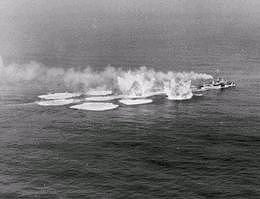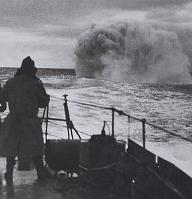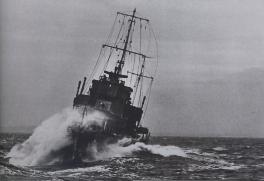

|
U-Boat Evasive Tactics
A U-boat’s best defense is concealment. But once this is blown, the next best recourse is to dive immediately. Ironically, if a U-boat is spotted on the surface, the first thing the escort will do is to shell it immediately and force it to submerge. This will break up the attack sequence and neutralize any threats of torpedo attacks. If given the opportunity, escorts will even ram a U-boat, whether it is on the surface or at periscope depth. The resulting damage will put the escort out of action for many months, but if that could sink a U-boat, then the price was considered well worth it.

|

|
| A destroyer launching a tight pattern of depth charges. | Launching depth charges was much a matter of guesswork. Sailors watched for underwater explosions and looked for debris for evidence of a kill. |
Once spotted, a U-boat requires at least 30 seconds to crash dive to a depth deep enough to evade the resulting depth charges. If the attacking vessel is too close, it might have better chances running on the surface to build up sufficient speed before ordering a crash dive. A U-boat can outrun most escorts, including corvettes, but not modern destroyers.
Once underwater, the cat and mouse hunt begins. The escort will be searching for the U-boat by listening in to the hydrophones and pinging with its sonar. On the U-boat, the hydrophone operator too will be listening in for the escort’s screws. He will be able to determine the location, speed and the type of ship (merchant or warship) on the surface. These will provide the only clues as to the activity on the surface.
Depth reduces the effectiveness of sonar. The deeper the U-boat, the more difficult it is to locate. A good evasive measure is to dive as deep as possible and as quickly as possible. This not only reduces the sonar signature, but also provides more time to evade depth charges and will keep the enemy guessing on the U-boat’s location by the time the depth charge reached the desired depth. Also, since sonar is more effective when pulsed at flat surfaces, a skilled commander will try to keep its bow or stern pointed towards the attacker as much as possible. U-boats are capable of very silent operations. But in order to remain undetected, it had to move very slowly underwater, which meant a low speed of only 2 knots. If this was not silent enough, the commander could further order the boat to run on silent mode. In this mode, all non essential activities are halted. Torpedo tubes are not reloaded, bilge pumps are run by hand and all non essential personnel are sent to the bunks. Silent operation keeps the U-boat’s noise low, and also helps to conserve battery power.

|
| Given the opportunity, escorts captains won't think twice about ramming a U-boat. |
U-boats could also launch BOLD canisters to confuse their attackers. Consisting of a chemical compound which emitted large quantities of gas, the resulting bubble cloud could resemble a submerged U-boat. Unless the sound operator was especially skilled, it was often difficult to distinguish it from a real U-boat. The allies called this a “Submarine Bubble Targer” (SBT).
It was not an easy task locating and attacking a submerged U-boat. Much skill and persistence was needed, and was especially so if the U-boat had already dived very deep beneath the sea. Sometimes escorts forced a U-boat to the surface by waiting it out. Since U-boats had very low underwater speed, escort captains knew that it could not travel very far. In addition, it could not remain submerged for very long periods. Appreciating the fact that carbon dioxide levels will start to rise, escorts will often wait in silence until the U-boat was forced to surface by itself due to the lack of breathing air. During the war, more than a handful of U-boats were defeated by sheer patience.



